In a world increasingly influenced by globalization, music serves as a powerful conduit for cultural exchange. The latest research by Ma and Zeng delves into the intricate relationship between contemporary global music and national music education systems. Their findings offer profound insights into how the infusion of global musical styles is reshaping traditional music curricula, pedagogical approaches, and students’ learning experiences.
As contemporary music genres gain popularity worldwide, they bring with them new rhythmic patterns, instrumentation, and cultural narratives that transcend geographic boundaries. The researchers utilized Partial Least Squares Structural Equation Modeling (PLS-SEM) to quantitatively analyze data gathered from diverse educational institutions. This sophisticated statistical tool allows for the exploration of complex relationships between variables, making it an ideal choice for this multidimensional study.
A noteworthy observation from their study indicates that exposure to global music influences students’ engagement and interest in their local music education. Traditional music forms, once stalwart in their standing, are now being re-evaluated through the lens of the global soundscape. Students who are introduced to contemporary global music often demonstrate a heightened enthusiasm for participating in music programs, as these new styles provide a relatable context that resonates with their personal experiences.
Moreover, the research highlights a shift in pedagogical methodologies among music educators. As global music styles become integrated into curricula, teachers are adopting innovative approaches that encourage creativity and improvisation. The focus has expanded beyond mere technical proficiency in traditional forms, with educators seeking to cultivate a more holistic understanding of music as a living, evolving craft that connects learners to a wider world.
The authors emphasize the potential advantages of this blending of musical styles within educational contexts. For instance, when students learn about various genres from around the globe, it not only broadens their musical vocabulary but also fosters cultural sensitivity and appreciation. This genre blending compels students to step outside their musical comfort zones, ultimately enriching their learning experiences and expanding their artistic capacities.
Furthermore, the implications of these changes extend beyond the classroom. As students become more engaged with global music trends, they carry these influences into their performances and compositions, paving the way for innovative works that reflect a fusion of cultural influences. The research suggests that contemporary music education has the potential to not only preserve traditional musical forms but also invigorate them with fresh, dynamic elements that reflect a globalized society.
Another significant finding from Ma and Zeng’s study speaks to the role of technology in facilitating this blending of musical influences. The advent of digital music platforms has made global music more accessible than ever before. Students can easily discover, listen to, and interact with music from different cultures, which informs their understanding and appreciation of diverse musical traditions.
The interaction with global music does not merely serve as an educational enhancement; it also encourages students to forge connections with their peers across cultural divides. Collaborative projects that incorporate various musical styles foster teamwork and collective creativity, promoting an understanding of music as a universal language. Such interactions instill a sense of community among students, regardless of their individual backgrounds or musical preferences.
Despite these advantages, the authors caution against an uncritical adoption of global music trends. They argue that it is essential for music educators to maintain a balance between honoring traditional musical heritage and embracing contemporary influences. The integrity of national music education systems relies not only on embracing current trends but also on ensuring that indigenous musical practices are preserved and valued within the educational framework.
In the findings, Ma and Zeng also advocate for policy changes at the institutional level to support these evolving educational practices. They propose that music education programs reflect an inclusive curriculum that accommodates the rich tapestry of global music while remaining rooted in national traditions. Such policy shifts would ensure that future generations of music students are equipped with the skills necessary to engage in a well-rounded and culturally diverse musical landscape.
The implications of this research stretch to the larger discourse on cultural globalization and preservation. As nations grapple with maintaining their distinct cultural identities amidst a tide of global influences, music education emerges as a crucial arena for cultural negotiation. By integrating contemporary global music into national curricula, countries can engage in a dialogue that respects their historical musical contexts while simultaneously welcoming new influences.
As Ma and Zeng’s study illustrates, the world of music education is undergoing a significant transformation. Educators are faced with both challenges and opportunities as they navigate the complexities of these changes. By embracing contemporary global music within national frameworks, music education can become a powerful means of fostering cultural understanding, creativity, and innovation among students.
This research stands as a clarion call for music educators to reflect on their practices and engage with the universal dialogue that contemporary music inspires. The path forward requires not just an acknowledgment of global influences but a commitment to thoughtful integration that honors diverse musical traditions, ensuring that music education remains relevant and inspiring in an ever-evolving global cultural context.
Subject of Research: Influence of contemporary global music on national music education
Article Title: Exploring the influence of contemporary global music on national music education: a PLS-SEM analysis
Article References:
Ma, R., Zeng, D. Exploring the influence of contemporary global music on national music education: a PLS-SEM analysis.
High Educ (2025). https://doi.org/10.1007/s10734-025-01552-7
Image Credits: AI Generated
DOI:
Keywords: Contemporary music, global music education, national music curriculum, PLS-SEM, cultural exchange.




